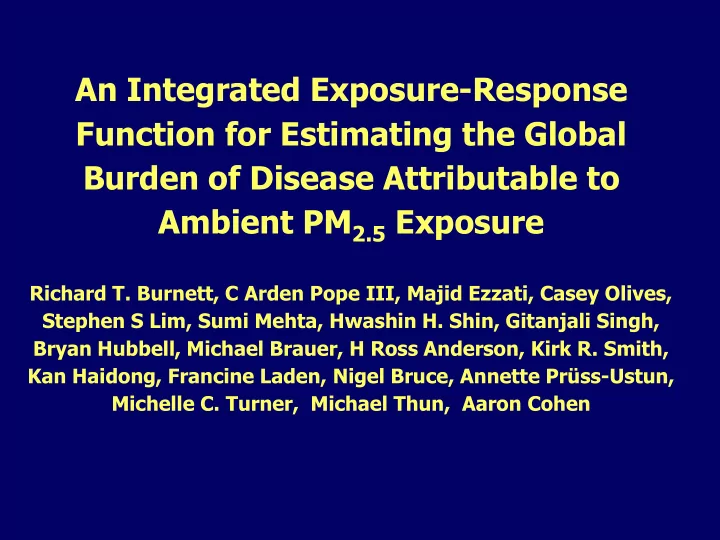

An Integrated Exposure-Response Function for Estimating the Global Burden of Disease Attributable to Ambient PM 2.5 Exposure Richard T. Burnett, C Arden Pope III, Majid Ezzati, Casey Olives, Stephen S Lim, Sumi Mehta, Hwashin H. Shin, Gitanjali Singh, Bryan Hubbell, Michael Brauer, H Ross Anderson, Kirk R. Smith, Kan Haidong, Francine Laden, Nigel Bruce, Annette Prüss-Ustun, Michelle C. Turner, Michael Thun, Aaron Cohen
http://www.thelancet.com/themed/global-burden-of disease
Distributions of selected regional 2005 2005 population-weighted regional estimated 3 estimated PM 2.5 by urban and rural areas average PM 2.5
Needed: a risk model for PM 2.5 exposure over the entire global range
Integrated E-R functions for cause-specific adult mortality Burnett et al. 2013 Submitted
Modification of Ambient Air Pollution Relative Risk by Age Burnett et al. 2013 Submitted
GBD risk functions predict risks from recent Chinese cohort study Burnett et al. 2013 Submitted
Distributions of Country- and Cause-specific Population Attributable Fractions for 2005 Burnett et al. 2013 Submitted
Top 15 Global Risk Factors in 2010 http://www.healthmetricsandevaluation.org/gbd/visualizations/country
Useful characteristics of IER • Reduces uncertainty relative to approaches that use only AAP cohort results by borrowing information from other combustion sources to estimate AAP RR at high ambient levels • Can estimate risk over entire range of current human exposure to ambient PM 2.5 including places where no studies have been conducted, e.g., much of Asia, Africa, and the Middle East and some parts of Europe • Allows RR to be estimated for outcomes and exposures for which no studies have been conducted, e.g., IHD/stroke and HAP in GBD 2010 • Allows RRs for PM 2.5 from different sources to be estimated in a consistent fashion for a common outcome, e.g., ALRI and AAP and HAP in GBD 2010 • Flexibilty. IER function can take many shapes. When compared to other functions used in burden estimation IER fit best • Easily updated to respond to new evidence. Allows new studies of ambient air pollution or other PM sources to be included without access to primary data including future studies at high ambient levels (obviating the need to use AS estimates)
Future Research • Examine sensitivity of RR predictions to • Alternate RR source-specific input data, e.g., for active smoking • Alternate assignment of equivalent ambient PM 2.5 concentrations for SHS and active smoking • Alternate RR input (Bayes) weighting schemes • Include studies of additional new PM sources, e.g. occupational studies • Fit IER model to cohort study data • Estimate “total” PM exposure from ambient, SHS, active smoking and occupation • Compare predictions over ambient levels with GBD estimates
For more information on the IER Rick Burnett Rick.Burnett@hc-sc.gc.ca Aaron Cohen acohen@healtheffects.org
Recommend
More recommend